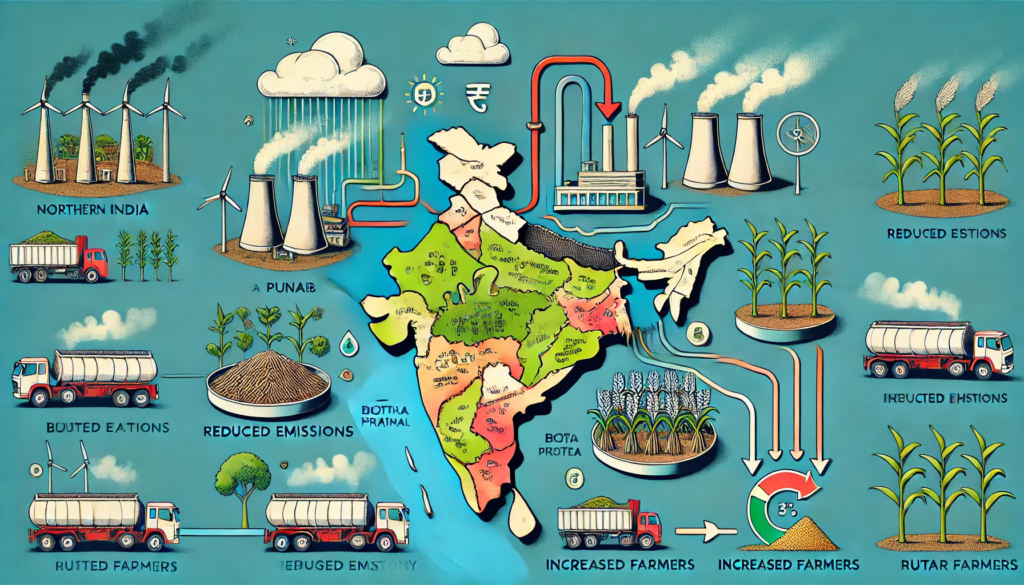Introduction
Stubble burning has long been a major cause of air pollution in northern India, especially during the winter months. Farmers in states like Punjab, Haryana, and Uttar Pradesh burn crop residue after harvesting, as it’s the quickest and cheapest way to clear their fields for the next sowing season. However, this practice releases massive amounts of carbon dioxide, methane, and other harmful pollutants into the atmosphere, leading to smog, poor air quality, and health problems across cities like Delhi.
Recently, the central government announced a significant step: doubling the penalties for stubble burning. This move is part of a larger effort to curb pollution and encourage alternative methods for managing crop residue. But while stricter penalties may act as a deterrent, they are not a standalone solution.
This is where bioethanol production, led by companies like Khaitan Bio Energy, offers a sustainable alternative that benefits farmers, reduces pollution, and helps the planet.
The Problems with Stubble Burning
Every winter, the burning of paddy stubble creates a choking smog that affects millions. According to studies, stubble burning contributes nearly 30-40% of Delhi’s winter air pollution. Here’s why the problem persists:
Cost-Effective for Farmers:
Burning stubble is a quick and inexpensive method to clear fields. Alternatives like machinery for residue management are costly and require government subsidies.
Time Constraints:
Farmers have a narrow window between harvesting one crop and planting the next. Burning is faster than manual or mechanical clearing methods.
Lack of Awareness:
Many farmers are unaware of the long-term environmental and health impacts of stubble burning.
The recent decision to increase penalties is a step in the right direction, but these measures alone won’t address the underlying challenges.
The Promise of Bioethanol Production
Bioethanol production offers a win-win solution by turning agricultural waste, including stubble, into a valuable resource. Khaitan Bio Energy is at the forefront of this movement, using cutting-edge technology to convert crop residue into 2G ethanol (second-generation ethanol). This approach directly tackles the issue of stubble burning while creating multiple benefits.
How Bioethanol Helps Farmers
Additional Income: Instead of burning stubble, farmers can sell their crop residue to bioethanol producers like Khaitan Bio Energy. This not only prevents pollution but also provides an extra source of income.
No Burning, No Fines: With the recent doubling of penalties for stubble burning, farmers now have a financial incentive to avoid the practice. Selling crop residue becomes a much better option.
Awareness and Training: Biofuel plants work closely with farmers, educating them on the benefits of residue collection and how it can lead to sustainable farming practices.
How Bioethanol Benefits India
Cleaner Air: By reducing stubble burning, bioethanol production helps combat smog and improve air quality, especially in northern cities.
Energy Security: Bioethanol can be blended with petrol, reducing India’s dependence on imported crude oil and promoting renewable energy. The government’s target of 20% ethanol blending by 2025 aligns with this goal.
Economic Growth: The bioethanol industry creates jobs in collection, transportation, and production, contributing to India’s rural and overall economic development.
How Bioethanol Helps the Planet
Lower Carbon Emissions: Using bioethanol as a fuel significantly reduces greenhouse gas emissions compared to traditional fossil fuels.
Sustainable Resource Use: Turning agricultural waste into energy promotes a circular economy, where nothing is wasted.
Global Climate Goals: India’s efforts in bioethanol production contribute to global goals for reducing emissions and fighting climate change.
Impact of Bioethanol on Pollution and Agriculture
- A comparison of pollution levels before and after reducing stubble burning through bioethanol production.
- Benefits for farmers, including additional income and lower penalties.
- Bioethanol’s contribution to India’s energy security and carbon footprint reduction.

The Road Ahead
While doubling penalties for stubble burning is a strong step, it’s clear that solutions need to go beyond enforcement. Bioethanol production, as pioneered by Khaitan Bio Energy, offers a sustainable alternative that aligns the interests of farmers, policymakers, and environmentalists.
However, for this solution to reach its full potential, it requires strong government support in the form of subsidies, awareness campaigns, and partnerships with private players. Farmers need easy access to equipment for collecting crop residue and fair compensation for their contribution to bioethanol production.Together, these efforts can help India breathe cleaner air, achieve its energy goals, and set a global example for sustainable development.
By turning waste into wealth, we can pave the way for a cleaner, greener future—one where penalties are no longer needed because burning stubble becomes a thing of the past.

